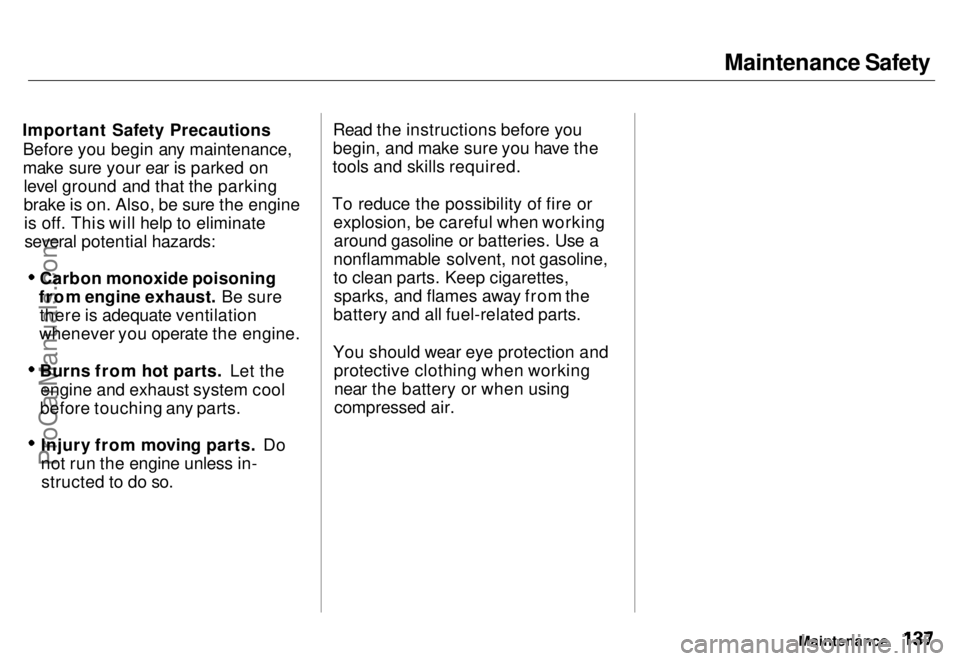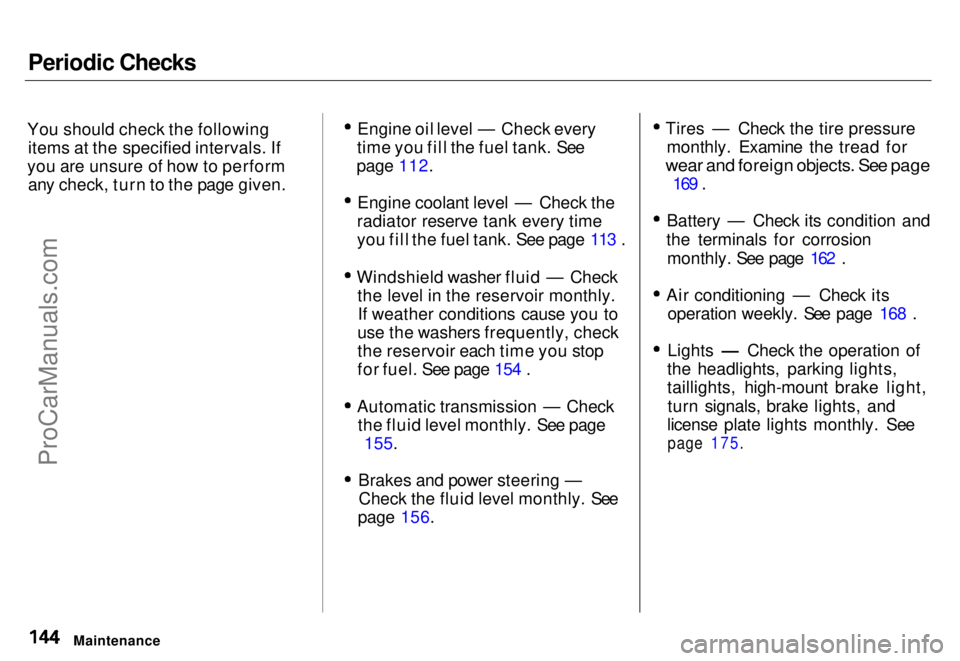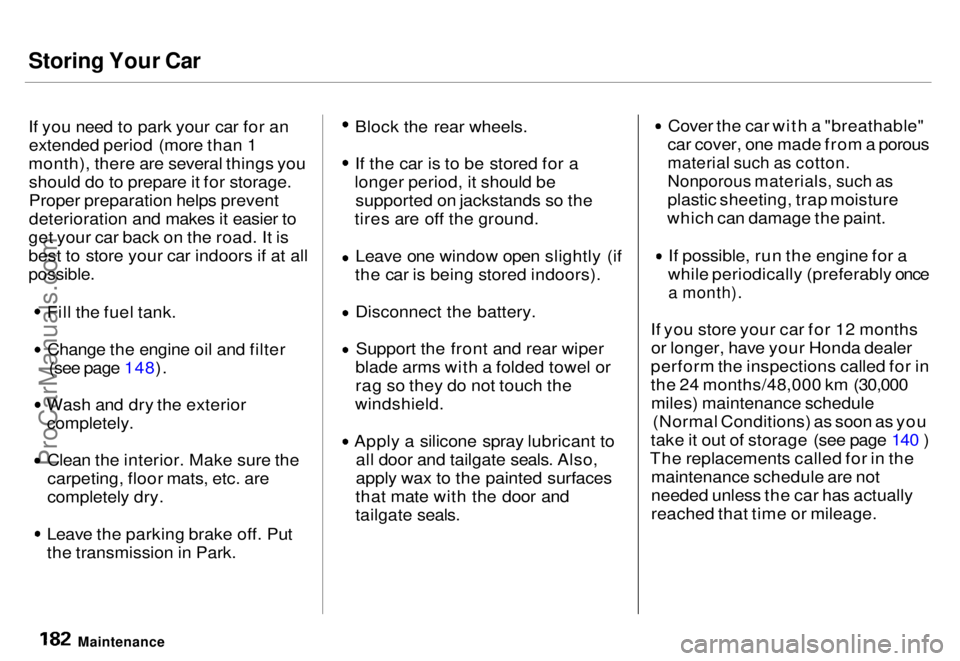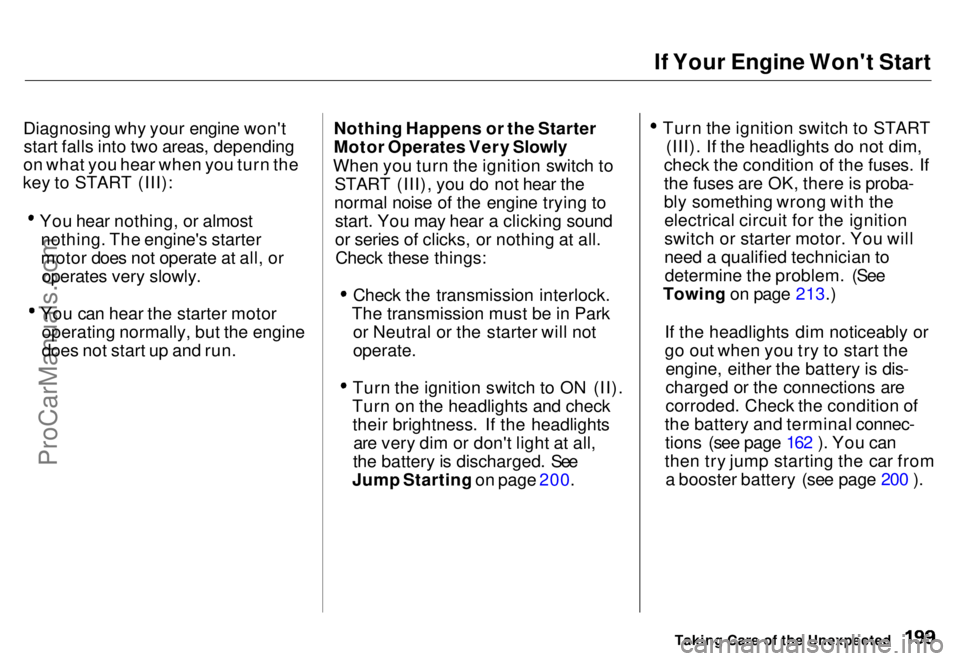Page 136 of 240

Maintenance Safety
Important Safety Precautions Before you begin any maintenance,
make sure your ear is parked on level ground and that the parking
brake is on. Also, be sure the engineis off. This will help to eliminateseveral potential hazards:
Carbon monoxide poisoning
from engine exhaust. Be sure there is adequate ventilation
whenever you operate the engine.
Burns from hot parts. Let the engine and exhaust system cool
before touching any parts.
Injury from moving parts. Do
not run the engine unless in-structed to do so. Read the instructions before you
begin, and make sure you have the
tools and skills required.
To reduce the possibility of fire or explosion, be careful when workingaround gasoline or batteries. Use a
nonflammable solvent, not gasoline,
to clean parts. Keep cigarettes, sparks, and flames away from the
battery and all fuel-related parts.
You should wear eye protection and protective clothing when workingnear the battery or when using
compressed air.
MaintenanceProCarManuals.comMain Menu s t Table of Contents
Page 143 of 240

Periodic Checks
You should check the following items at the specified intervals. If
you are unsure of how to perform any check, turn to the page given. Engine oil level — Check every
time you fill the fuel tank. See
page 112.
Engine coolant level — Check the
radiator reserve tank every time
you fill the fuel tank. See page 113 .
Windshield washer fluid — Check the level in the reservoir monthly.If weather conditions cause you to
use the washers frequently, check
the reservoir each time you stop
for fuel. See page 154 .
Automatic transmission — Check the fluid level monthly. See page 155.
Brakes and power steering — Check the fluid level monthly. See
page 156. Tires — Check the tire pressure
monthly. Examine the tread for
wear and foreign objects. See page
169 .
Battery — Check its condition and
the terminals for corrosion monthly. See page 162 .
Air conditioning — Check its operation weekly. See page 168 .
Lights — Check the operation of
the headlights, parking lights,
taillights, high-mount brake light,
turn signals, brake lights, and
license plate lights monthly. See
page 175.
MaintenanceProCarManuals.comMain Menu s t Table of Contents
Page 149 of 240
Engine Oil, Cooling System
If you change your own oil, pleasedispose of the used oil properly. Put it in a sealed container and take it to arecycling center. Do not discard it in a
trash bin or dump it on the ground.
Checking the Engine Coolant
Level
Check the level of the engine coolant
by looking at the radiator reserve tank next to the battery. If the coolant level in the reserve tank is ator below the MIN line, add coolant to
bring it up to the MAX line. Inspect the cooling system for leaks. Thiscoolant should always be a mixtureof 50% antifreeze and 50% water.
Never add straight antifreeze or
plain water. Always use Genuine Honda Anti-
freeze/Coolant. The cooling systemcontains many aluminum compo-nents that can corrode if an improper
antifreeze is used. Some antifreeze,even though labeled as safe for
aluminum parts, may not provideadequate protection.
Maintenance
RESERVE TANK
MIN
MAX
NOTICEProCarManuals.comMain Menu s t Table of Contents
Page 161 of 240
Battery
Check the condition of your car's
battery monthly. You should check for proper electrolyte level andcorrosion on the terminals. Emergency Procedures
Eyes — Flush with water from a cup
or other container for at least fifteen
minutes. (Water under pressure can damage the eye.) Immediately call a
physician or 911.
Skin — Remove contaminated
clothing. Flush the skin with large quantities of water. Call a physician
immediately.
Swallowing — Drink water or milk.Call your local Poison Control Center
or a physician immediately.
Maintenance
The battery contains sulfuric
acid (electrolyte) which is highly
corrosive and poisonous.
Getting electrolyte in your eyes
or on your skin can cause
serious burns.
Wear protective clothing andeye protection when workingnear the battery.ProCarManuals.comMain Menu s t Table of Contents
Page 162 of 240
Battery
TEST INDICATOR WINDOW
Check the battery condition by
looking at the test indicator window on the battery:
Blue — Good conditionRed — Add distilled water
White — Charging necessary Check the battery terminals for
corrosion (a white or yellowish
powder). To remove it, cover the terminals with a solution of bakingsoda and water. It will bubble up and
turn brown. When this stops, wash it off with plain water. Dry off the
battery with a cloth or paper towel. Coat the terminals with grease to
help prevent future corrosion.
If the terminals are severely cor-
roded, clean them with baking soda and water. Then use a wrench to
loosen and remove the cables from the terminals. Always disconnect the
negative (—) cable first and recon-nect it last. Clean the battery termi-
nals with a terminal cleaning tool or
wire brush. Reconnect and tighten
the cables, then coat the terminals
with grease.
Maintenance
CONTINUEDProCarManuals.comMain Menu s t Table of Contents
Page 163 of 240
Battery
If you need to connect the battery to
a charger, disconnect both cables to
prevent damage to the car's electri-
cal system.
On the U.S. EX model
If your car's battery is disconnected
or goes dead, the audio system will disable itself. The next time you turn
on the radio you will see "Code" in
the frequency display. Use the
Preset buttons to enter the five-digit
code (see page 106). Charging the battery with the cables
connected can seriously damage your
car's electronic controls. Detach the
battery cables before connecting the
battery to a charger.
Maintenance
The battery gives off explosive
hydrogen gas during normal
operation.
A spark or flame can cause the battery to explode with enough
force to kill or seriously hurt you.
Wear protective clothing and a
face shield, or have a skilled mechanic do the battery
maintenance.
NOTICEProCarManuals.comMain Menu s t Table of Contents
Page 181 of 240

Storing Your Car
If you need to park your car for an
extended period (more than 1
month), there are several things you should do to prepare it for storage.
Proper preparation helps prevent
deterioration and makes it easier to
get your car back on the road. It is
best to store your car indoors if at all
possible.
Fill the fuel tank.
Change the engine oil and filter
(see page 148). Wash and dry the exterior
completely.
Clean the interior. Make sure the
carpeting, floor mats, etc. are
completely dry.
Leave the parking brake off. Put
the transmission in Park. Block the rear wheels.
If the car is to be stored for a
longer period, it should be supported on jackstands so the
tires are off the ground.
Leave one window open slightly (if
the car is being stored indoors).
Disconnect the battery.Support the front and rear wiper
blade arms with a folded towel or
rag so they do not touch the
windshield. Apply a silicone spray lubricant to
all door and tailgate seals. Also,
apply wax to the painted surfaces
that mate with the door and
tailgate seals. Cover the car with a "breathable"
car cover, one made from a porous
material such as cotton.
Nonporous materials, such as
plastic sheeting, trap moisture
which can damage the paint. If possible, run the engine for a
while periodically (preferably once
a month).
If you store your car for 12 months or longer, have your Honda dealer
perform the inspections called for in
the 24 months/48,000 km (30,000 miles) maintenance schedule (Normal Conditions) as soon as you
take it out of storage (see page 140 )
The replacements called for in the maintenance schedule are not
needed unless the car has actually
reached that time or mileage.
MaintenanceProCarManuals.comMain Menu s t Table of Contents
Page 197 of 240

If Your Engine Won't Start
Diagnosing why your engine won't start falls into two areas, depending
on what you hear when you turn the
key to START (III): You hear nothing, or almost
nothing. The engine's starter
motor does not operate at all, oroperates very slowly. You can hear the starter motor
operating normally, but the engine
does not start up and run. Nothing Happens or the Starter
Motor Operates Very Slowly
When you turn the ignition switch to START (III), you do not hear the
normal noise of the engine trying to start. You may hear a clicking sound
or series of clicks, or nothing at all.Check these things:
Check the transmission interlock.
The transmission must be in Park or Neutral or the starter will not
operate.
Turn the ignition switch to ON (II).
Turn on the headlights and check their brightness. If the headlights are very dim or don't light at all,
the battery is discharged. See
Jump Starting on page 200. Turn the ignition switch to START
(III). If the headlights do not dim,
check the condition of the fuses. If
the fuses are OK, there is proba-
bly something wrong with the electrical circuit for the ignition
switch or starter motor. You will
need a qualified technician todetermine the problem. (See
Towing on page 213.)
If the headlights dim noticeably or
go out when you try to start theengine, either the battery is dis-
charged or the connections are
corroded. Check the condition of
the battery and terminal connec- tions (see page 162 ). You can
then try jump starting the car from a booster battery (see page 200 ).
Taking Care of the UnexpectedProCarManuals.comMain Menu s t Table of Contents